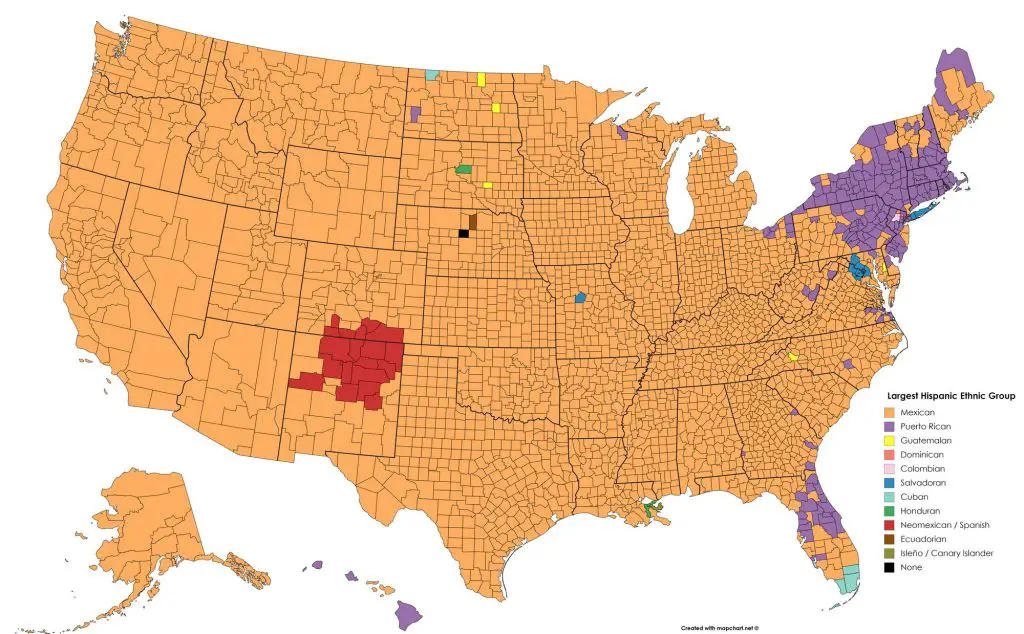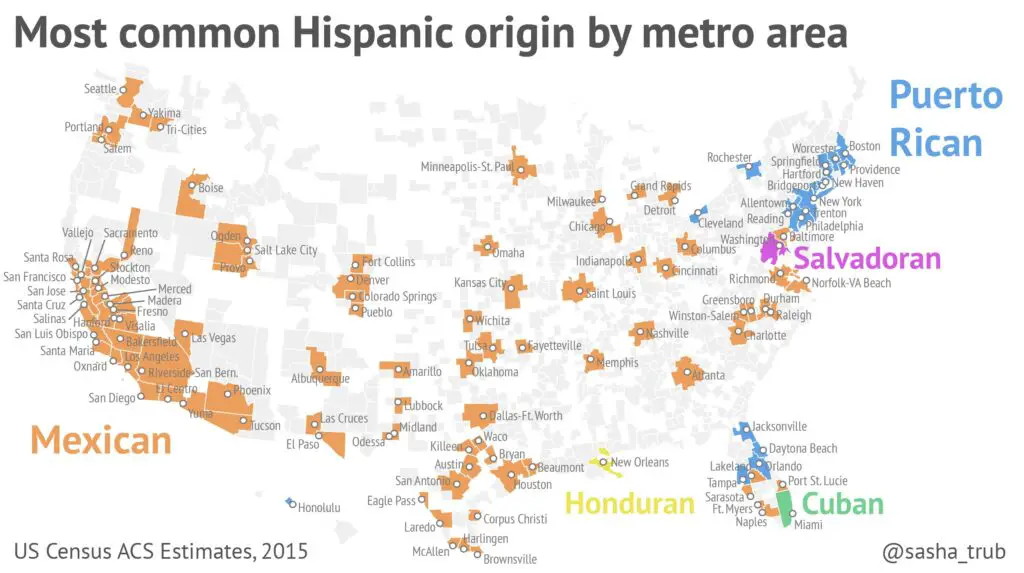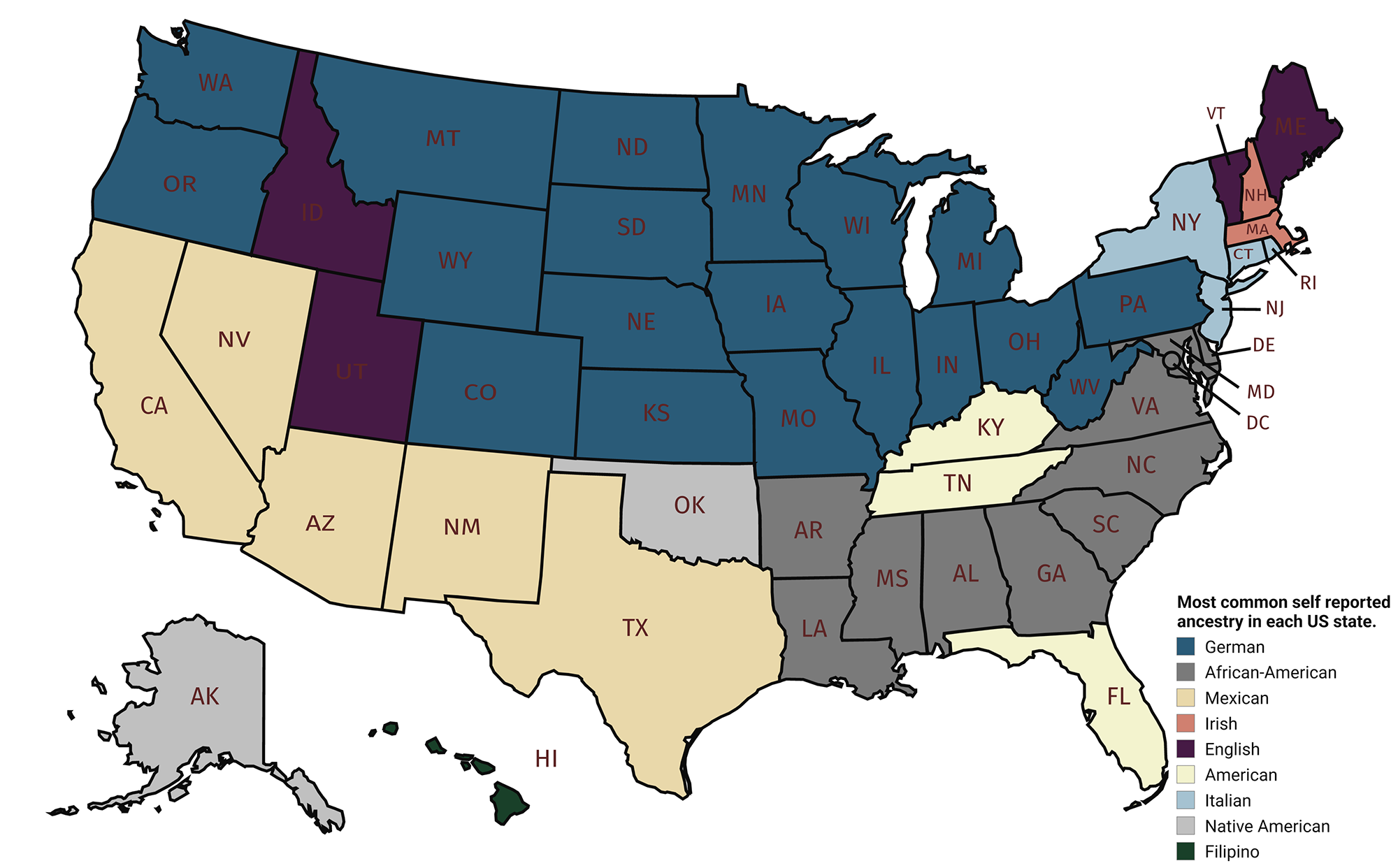Map of the largest Hispanic ethnic group in each U.S. county
According to the Census Bureau, nearly 65 million Hispanics and Latinos were living in the U.S. (19.5% of the overall population) in 2020; 2/3 of them have Mexican origin. Puerto Ricans, the nation’s second-largest Hispanic origin group. The map below shows the most prominent Hispanic groups in the United States.

More than half (54%) of the nation’s Hispanics live in 15 metropolitan areas. Los Angeles-Long Beach-Anaheim metro area, followed by the New York-Newark-Jersey City metro area, has the largest Hispanic population. Below is the map of the most common Hispanic origin by metro area created by Sasha Trubetskoy.

Mexican Americans (36,668,018) are the largest Hispanic group in the U.S. by a longshot. Making up around 67.8% of the country’s Hispanic population, Mexican Americans can be found in practically any area of any U.S. state. The highest concentrations of Americans claiming Mexican ancestry are in the American Southwest (California, Texas, Arizona). Their population is so high in these U.S. states that they represent the most significant overall ethnic group in many cities and counties. Some areas, such as the Texas border region (El Paso, Brownsville, McAllen), are almost entirely Mexican American.
Puerto Ricans (5,588,664 not including Puerto Rico) – Making up 10.3% of the Hispanic population in the U.S., Puerto Ricans make up the second-largest Hispanic ethnic group in the United States. Due to all Puerto Ricans having U.S. citizenship, they can simply immigrate to the mainland, whereas other Hispanic groups have a much more difficult time. Therefore, their population is steadily growing, and there are currently over 2 million more Puerto Ricans living on the mainland than there are living in Puerto Rico. The mainland Puerto Rican population is most leading in the Northeast, especially in New York City. The over 1 million Puerto Ricans in New York are spread around the city, but notable ethnic enclaves include Williamsburg, Spanish Harlem, and South Bronx; collectively, Puerto Ricans from New York are referred to as “Nuyoricans” by many.
Cuban Americans (2,315,863 – 4.3%) are primarily descendants of political emigrants. Cuban Americans make up the third-largest Hispanic group in the country. The highest concentration of Cubans in the United States is, without a doubt, Southern Florida, especially Miami. Their influence in this region runs deep, and they are the largest ethnic group in this area. In interest to Southern Florida, there are smaller but thriving communities spread around the country in major cities such as New York City, Central & Northern Florida, and New Jersey.
Salvadoran Americans (2,310,734 – 4.3%) are the fourth-largest Hispanic group in the U.S. The largest Salvadoran population can be found in California’s Los Angeles / Inland Empire region; however, their population is dominated by the significant Mexican American presence in SoCal, which means they do not show up on California’s map. Yet, Salvadorans have a substantial presence on the East Coast and even make up the majority Hispanic ethnic group in the Washington DC metro area (including Northern Virginia and Maryland) and Long Island, New York. Outside of these large, well-established populations, Salvadoran Americans are well scattered throughout many states across the U.S. and can usually be found mostly in rural counties. Some of these thriving communities include Northwest Arkansas, Atlanta, and Massachusetts.
Dominican Americans (2,081,419 – 3.8%) – Despite only making up the majority Hispanic ethnic group in 2 counties, Dominican Americans are the fifth-largest Hispanic ethnic group in the U.S. They are almost entirely concentrated in the New York City metro area, which is home to many other Hispanic communities, most notably Puerto Ricans. The most populous Dominican communities in the New York City metro area are in Upper Manhattan (Inwood, Washington Heights, etc.), West Bronx, and North Jersey.
Guatemalan Americans (1,456,965 – 2.7%) do not have one part of the country in which they are the dominant Hispanic ethnic group. The first significant Guatemalan American community can be found in southern California, especially Los Angeles, Orange, Riverside, and San Diego counties. The other considerable population is in the Northeast Corridor, particularly Maryland, New Jersey, the Delmarva Peninsula, and Rhode Island. Like Salvadoran Americans, Guatemalan Americans are also spread out in smaller populations throughout the country, mostly in rural areas due to the high number of Central American migrant farmworkers in the U.S.
Colombian Americans (1,222,960 – 2.3%) make up the largest South American ethnic group in the U.S. There are two main Columbian American communities, one in South Florida (specifically Weston, Doral, Kendall, and Hialeah) and one in the New York City metropolitan area (specifically Morris County, New Jersey and the neighborhoods of Jackson Heights, Elmhurst, and Flushing in Queens).
Honduran Americans (945,916 – 1.7%) are the dominant Hispanic ethnic group in the New Orleans metropolitan area and continue to increase in that region. Other significant communities can be found in New York City and Southern Florida. Like most Central American ethnic groups, Hondurans can often be found in many rural counties around the country.
New Mexican & Spanish Americans / Neomexicans or Hispanos (~800,000 – 1.5%) are an ethnic group that is frequently found in northern New Mexico and southern Colorado. Neomexicans claim direct ancestry from Spain and have been in the New Mexico/Colorado area for hundreds of years. It sets them apart from more recent Mexican American immigrants to New Mexico. It is impossible to know the exact amount of Neomexicans in America due to there not being a census option for them; some choose “Spanish,” “Spaniard,” or even “Mexican,” but most simply markdown. “Other Hispanic Group.”
Ecuadorian Americans (712,084 – 1.3%) community is much smaller than most other Hispanic ethnic groups in the United States. The largest population of Ecuadorians is in New York City. However, as you can see, they do not show up on the map above at all around NYC; The only county where Ecuadorians are the most prominent Hispanic Group is Rock County (Nebraska), where only one Ecuadorian actually resides.
Top US counties by Hispanic origin group
Mexicans – Los Angeles County (California) ~ 4 million (Share of national Hispanic origin group population ~ 11%)
Puerto Ricans – Bronx County (New York) ~ 0,3 million (~6%)
Cubans – Diami-Dade County (Florida) ~0.9 million (~48%)
Salvadorans – Los Angeles County (California) ~ 0.4 million (~22%)
Dominicans – Bronx County (New York) ~ 0.3 million (~17%)
Guatemalans – Los Angeles (California) ~0.2 million (~21%)
Colombians – Miami-Dade County (Florida) ~0.1 million (~13%)
Hondurans – Miami-Dade County (Florida) ~54 thousand (~9%)
Peruvians – Miami-Dade County (Florida) ~41 thousand (~8%).
Every U.S. county, except for one (Blaine County, Nebraska), has at least one person of Hispanic origin living there. While many states have almost no Latino community, Blaine County is the only one with none living there at all.









That Canary Islander component in Louisiana is most interesting of all the Hispanic groups.
If you parse out Mexican Americans who descended from those who arrived before 1920, the end of the Mexican Civil War, its color would blanket much of the Southwest
Colombians…. not Columbians